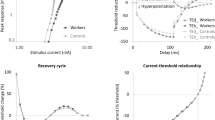Summary
Maximum motor nerve conduction velocities in the median nerve (MCV) and blood lead (PbB) were repeatedly measured in 14 lead exposed workers with an initial PbB from 0.7 to 4.0 μmol/kg (median 2.3 μmol/kg) for a period from 3 months to 7 years: A certain dose of Calcium Disodium Ethylenediaminetetraacetic Acid (CaEDTA) was injected intravenously into most of the subjects during the period.
In seven subjects, MCV improved by more than 4 m/s during the observation period which involved the first two successive measurements of MCV and PbB, but the remaining seven subjects showed the minimal alteration (within ± 4.0 m/s). The initial value of MCV was significantly slower (P < 0.01) and the decrease in PbB was significantly greater (P < 0.05) in the group of subjects having shown the improvement of MCV by more than 4 m/s.
The initial value of MCV was significant in determining the alteration in MCV in multiple regression analysis and, together with the change in PbB, explained 31% of the alteration in MCV between the first two successive measurements. The initial level of PbB, dose of CaEDTA, time interval between the measurements and age played no essential part in the alteration in MCV.
The alteration in MCV throughout the whole observation period in each subject significantly correlated with the concurrent change in PbB (r=−0.573, P < 0.001).
Similar content being viewed by others
References
Araki S, Homma T (1976) Relationships between lead absorption and peripheral nerve conduction velocities in lead workers. Scand J Work Environ Health 4:225–231
Buchthal F, Behse F (1979) Electrophysiology and nerve biopsy in men exposed to lead. Br J Ind Med 36:135–147
Catton MJ, Harrison MJG, Fullerton PM, Kazantzis G (1970) Subclinical neuropathy in lead workers. Br Med J 2:80–82
Graef JW (1979) Clinical aspects of lead poisoning. In: Vinken PJ, Bruyn GW (eds) Handbook of clinical neurology, Intoxication of the nervous system, part I. North-Holland, Amsterdam, p 1–34
Landrigan PJ, Baker EL, Jr, Feldman RG, Cox DH, Eden KV, Orenstein WA, Mather JA, Yankel AJ, Von Lindern IH (1976) Increased lead absorption with anemia and slowed nerve conduction in children near a lead smelter. J Pediatr 89:904–910
Lilis R, Fischbein A, Eisinger, J, Blumberg WE, Diamond S, Anderson HA, Rom W, Rice C, Sarkozi L, Kon S, Selikoff IJ (1977a) Prevalence of lead disease among secondary lead smelter workers and biological indicators of lead. Environ Res 14:255–285
Lilis R, Fischbein A, Diamond S, Anderson HA, Selikoff IJ, Blumberg WE, Eisinger J (1977b) Lead effects among secondary lead smelter workers with blood lead levels below 80 μg/100 ml. Arch Environ Health 32:256–266
Oh SJ (1975) Lead neuropathy, Case report. Arch Phys Med Rehabil 56:312–317
Paulev PE, Gry C, Døssing M (1979) Motor nerve conduction velocity in asymptomatic lead workers. Int Arch Occup Environ Health 43:37–43
Seppäläinen AM, Hernberg S (1972) Sensitive technique for detecting subclinical lead neuropathy. Br J Ind Med 29:443–449
Seppäläinen AM, Tola S, Hernberg S, Kock B (1975) Subclinical neuropathy at “safe” levels of lead exposure. Arch Environ Health 30:180–183
Seppäläinen AM (1977) Das Verhältnis zwischen Exposition und Auswirkung in der vom Blei hervorgerufenen subklinischen Neuropathie. Z Gesamte Hyg 23:644–646
Verberk MM (1976) Motor nerve conduction velocity in volunteers ingesting inorganic lead for 49 days. Int Arch Occup Environ Health 38:141–143
Zielhuis RL (1977) Secondary international workshop permissible levels for occupational exposure to inorganic lead. Int Arch Occup Environ Health 39:59–72
Author information
Authors and Affiliations
Rights and permissions
About this article
Cite this article
Araki, S., Honma, T., Yanagihara, S. et al. Recovery of slowed nerve conduction velocity in lead-exposed workers. Int Arch Occup Environ Health 46, 151–157 (1980). https://doi.org/10.1007/BF00378193
Received:
Accepted:
Issue Date:
DOI: https://doi.org/10.1007/BF00378193




